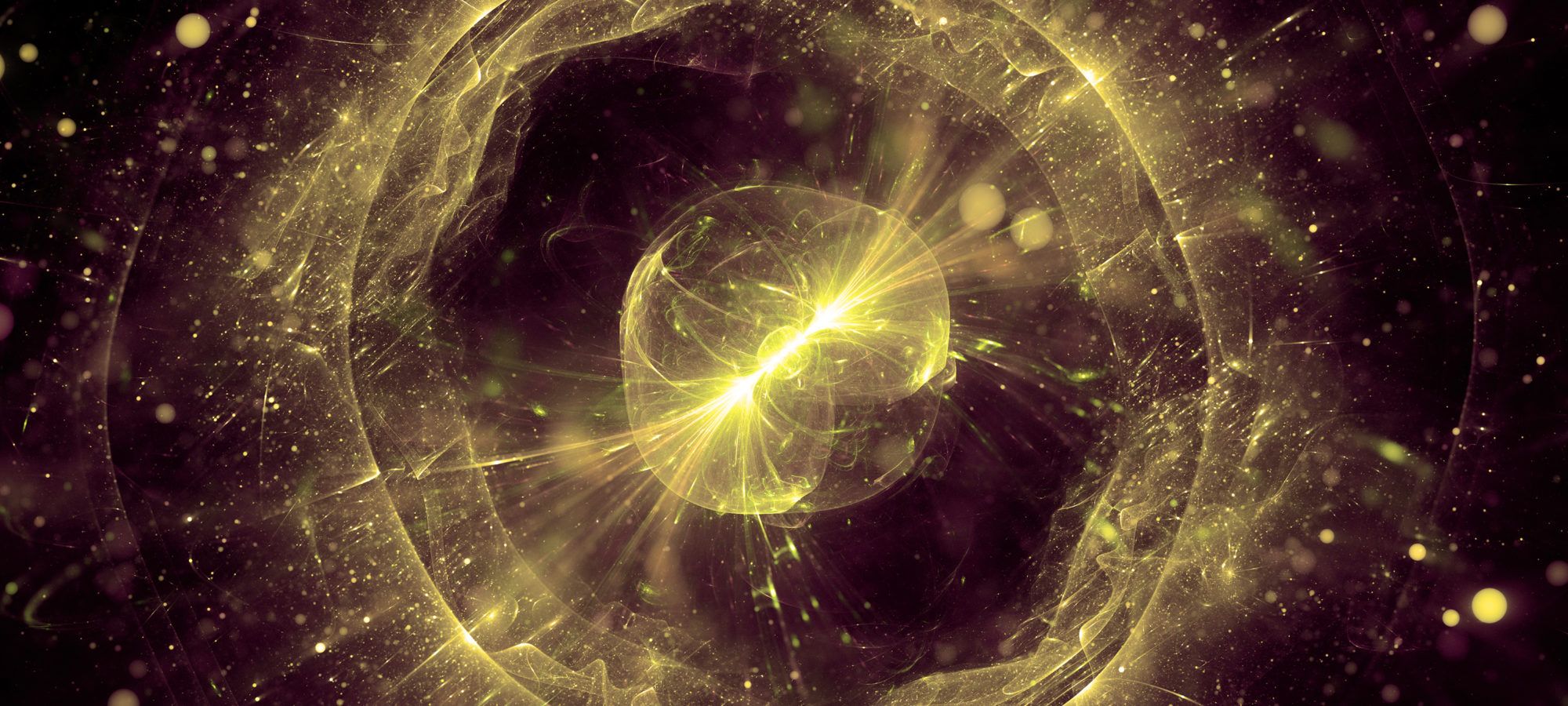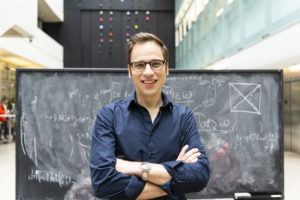A new spin on where gold comes from
A new model says that most of the gold in the universe comes from whirling, dying stars called collapsars.
Take a self-guided tour from quantum to cosmos!
A new model says that most of the gold in the universe comes from whirling, dying stars called collapsars.

Stellar astrophysicist Anna Frebel calls it “the last stardust secret”: Where does gold come from?
Perimeter’s newest associate faculty member, Daniel Siegel, thinks he finally knows.
Siegel, recently arrived from Columbia University in New York, collaborated with Columbia colleagues Jennifer Barnes and Brian D. Metzger. The team’s paper, just published in the journal Nature, introduces a new scenario for the cosmic processes that forge gold and other heavy elements.
“This year is the 150th anniversary of the periodic table of the elements,” Siegel notes. “To celebrate, we are overthrowing previous ideas about how the universe produces heavy elements.”

Physicists have a good handle on the top half of the periodic table – that is, on iron and everything lighter. Inside stars, fusion builds light elements created in the big bang into heavier ones, giving off energy at each step up the atomic staircase. In the largest stars, this essentially goes on until element number 26, iron. Fusion involving iron takes more energy than it gives off, so iron can’t be used to fuel a star. A star that has begun to produce iron is doomed – its core will collapse onto itself, while the outer shells are blown off in an explosion called a supernova.
So that’s the top half of the periodic table – its first three and a half rows. What about rows four, five, six, and seven? About half of these elements are thought to be produced by slowly adding neutrons to existing elements in the dense cores of certain giant stars. (These are known as s-process elements – “s” for slow neutron capture.) The origins of the other half – including, notably, gold – have been a mystery. They’re known to be produced by the r-process – “r” for rapid neutron capture – but where? Originally, it was believed that r-process elements were produced not during a star’s life, but during its death: in the supernova itself.
But the idea that gold was created during supernovas started taking hits in the late 1990s, when models began to suggest that the conditions needed for the r-process didn’t occur in most supernovas. Later, measurements comparing the composition of the earth’s crust with the composition of meteorites implied that r-process elements were not produced in small amounts by common processes, but in large amounts by rare processes. Again, that seemed to rule out ordinary core-collapse supernovas – which on cosmic scales count as common.
So if even exploding stars can’t build gold, where does it come from? “That’s a big mystery that’s been studied now for several decades,” says Siegel.
To drive the r-process, you need three things: “seed” particles such as iron nuclei, neutrons to fuse with the seed particles to make them heavier, and high density to bring the seed particles and the neutrons together. Supernovas lack the free neutrons. But one place that might have free neutrons is neutron star merger.
Neutron stars are the remnants of collapsed stars. They are so dense that the protons and electrons in them are kind of “squeezed together into neutrons,” says Siegel, forming neutron-rich matter so dense that a teaspoon of it weighs as much as a mountain. Ordinary neutron stars don’t eject material, but occasionally two neutron stars will collide – an event called a neutron star merger.
So, for the last few decades, neutron star mergers have been investigated as a probable origin of the universe’s gold. Not everyone was convinced, though: critics thought that neutron star mergers might be too rare or eject too little material to account for the observed abundance of heavy elements.
“In 2017, we had a great breakthrough,” says Siegel. “Gravitational wave observatories detected a neutron star merger.” In a triumph of multimessenger astronomy, optical telescopes turned to catch the afterglow. Then things got odd.
The thermal emission did not look quite as computer simulations of the collision had predicted it should. It was strong in the red and near-infrared, suggesting that the collision had ejected a large amount of material moving a relatively slow speeds – to experts, a strange combination.
Teams worldwide dug in to figure out what was happening.
As it happened, Siegel and colleagues had just built a computer model of the aftermath of neutron star collisions. “We actually had performed these simulations and submitted a paper a few months before the merger event,” he says.
When two neutron stars collide, the huge resulting mass may collapse under its own weight, forming a black hole. The debris left over from the collision forms a hot, fast-spinning whirlpool centred on the black hole. Such a whirlpool is called an accretion disk. Siegel’s model was focused on the detailed physics of the accretion disk.
“We discovered a very interesting physical mechanism in these accretion disks that had mostly been overlooked before,” says Siegel. The material in the accretion disk is so hot that individual atoms are torn apart into protons, neutrons, and electrons, and so dense that the electrons become degenerate. Electron degeneracy is a complex quantum mechanical concept – but its practical effect in this case is to increase the relative abundance of neutrons.
The new model was the first to take all important ingredients into account – electron degeneracy, weak force interactions, strong gravity, and magnetic fields – and therefore the first to spot the excess neutrons in the accretion disk and its outflows.
About those outflows: the model predicts that a wind blows outward from the hot accretion disk, carrying the excess neutrons with it. As the wind expands into space and cools, the protons and neutrons begin to fuse into seed particles, and left-over neutrons drive the r-process, creating heavy elements.
The team had created a model that showed the forging of cosmic gold in significant amounts. What’s more, the model predicted that the neutron star merger could eject more material than previously expected, giving rise to the strong red and near-infrared emissions – just as telescopes actually saw.
“It turned out that our prediction provided a natural explanation for the data,” says Siegel. That’s a rare treat for any scientist. But the team’s surprises didn’t stop there. They also discovered a brand-new source of r-process elements – collapsars.
“While we were working on neutron star merger accretion disks, we realized that the same physics – the physics that drives the accretion disk winds and produces the r-process elements – should also apply to very different astrophysical systems: namely, collapsars,” says Siegel. “Then we realized we were yet again on to something much bigger than we initially thought.”
A collapsar is a star with at least 20 or 30 solar masses, which is also rotating rapidly. At the end of their lives, these stars collapse into black holes – but not cleanly. The core collapses. The materials from the outer shells of the star continue to rotate, start to circularize, and form an accretion disk around the newborn black hole.
Just as in the neutron star merger, these accretion disks can be rich sources for r-process elements like gold.
Indeed, the team thinks that most of the universe’s gold comes from collapsars, not neutron star mergers at all. “These accretion disks are actually much more massive, simply because there were 20 or 30 solar masses of material there to begin with,” notes Siegel. More matter to start with means potentially more r-process elements coming out. The team calculates that about 80 percent of r-process elements come from collapsars, with only 20 percent coming from neutron star mergers.
It’s a new answer to an old question, the cracking of that “last stardust secret.”
What’s more, it’s testable. Siegel and colleagues are coaxing their model to make predictions about what they should – and shouldn’t – see if a telescope can get a collapsar-type supernova in its sights and study it over time. Siegel is excited: “It’s not often that you have some theoretical idea and come to a conclusion that’s interesting – and testable in a fairly straightforward way.”
They’ll need luck to catch a collapsar with a telescope. Our own galaxy has largely aged-out of the stage where it makes collapsars. “Collapsars mostly occur in distant galaxies, with only very few in galaxies nearby,” says Siegel. “We need one of the latter to study the supernova for long enough – distant supernovae fade too quickly below detectable levels.”
“We’re working with observers,” says Siegel. “Chances are pretty good that we might spot an interesting nearby collapsar in the next three to eight years.” That would give Siegel’s team, and indeed the whole community, a chance to put the new model for gold production to a crucial test.
In the meantime, we can look at the periodic table – and the gold in our rings – with a little better understanding, and a little more wonder.
Watch: The team’s simulation shows the aftermath of a neutron star merger or collapsar-type supernova. The spinning black hole in the centre is surrounded by a hot, dense whirlpool of debris called an accretion disk. (The top view cuts through the disk to show how the density changes layer by layer. The bottom view shows the disk as if from above.) Only about 60 percent of the material fed into the disk will fall into the black hole. The other 40 percent will be ejected by winds. That ejected material is thought to be the origin of the universe’s r-process elements, including gold.
On July 27, Juan Maldacena, a luminary in the worlds of string theory and quantum gravity, will share his insights on black holes, wormholes, and quantum entanglement.
Clouds of particles surrounding some black holes could create smaller versions of cosmic strings and provide insights into dark matter, according to research by Perimeter’s William East.
Is the universe a hologram? Celestial holography researchers, like Perimeter’s Ana-Maria Raclariu, are exploring the idea as a new way of approaching quantum gravity.